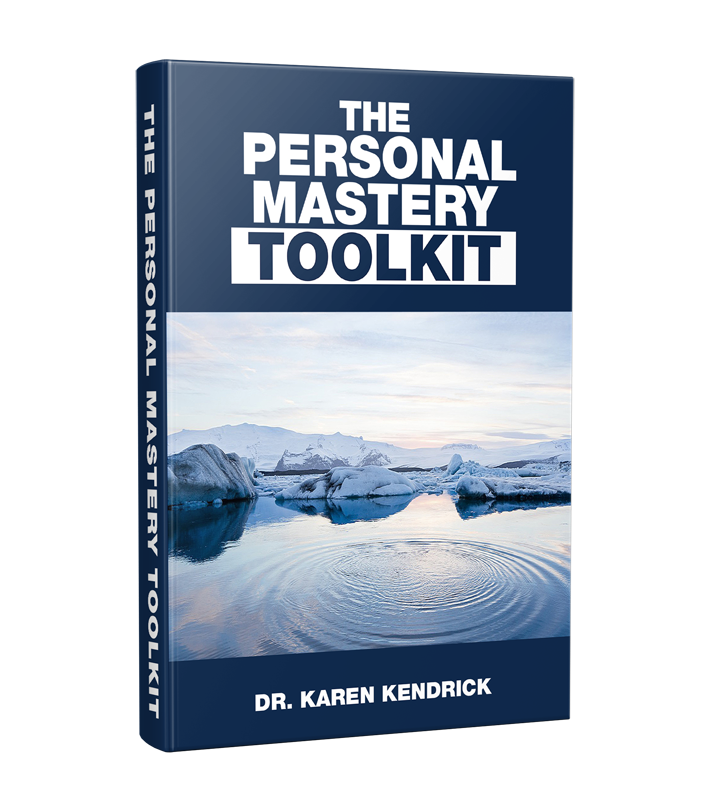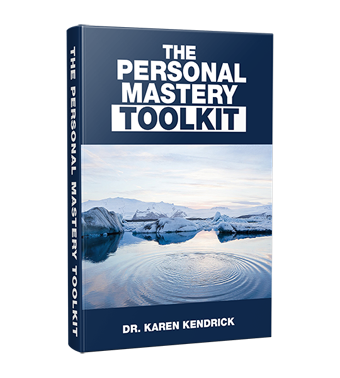HOW TO DEAL WITH BURNOUT AND GET YOUR LIFE BACK
ABOUT THE EPISODE
Feeling burned out? Learn the telltale signs and symptoms of burnout and what you can do to address them to get yourself back on track.
TRANSCRIPT
If we’ve learned anything over the last few years or just been reminded, it’s that our physical, mental and emotional health has got to be a priority. If we’re going to have the energy, motivation, and resilience to go after what we want and get through difficult periods, it all starts with our well-being.
Hey, Everyone, it’s Dr. Karen Kendrick, and Welcome to Mastery Now.
You know, if you’ve been feeling burned out right now, at your job or in your life, you are in good company. I think so many of us can relate to feeling tired or stressed or just not at our best.
You know, with everything that’s been happening over the last two years in particular, burnout has really reached epidemic proportions. There’s been studies that have suggested that up to 77% of U.S. professionals right now are feeling burned out. That was based on a study by Deloitte in the last 18 months.
There’s also been studies done by Monster.com, and Indeed.com, with burnout rates ranging anywhere from 52% to 69%. So that’s pretty epic. That’s pretty major.
What I want to do in this episode is walk you through some ideas about how to deal with burnout and get your life back on track.
So first of all, let’s just talk about what it is. Most of the time, it’s just physical and mental exhaustion brought on by prolonged excessive stress. Now, it’s mostly been talked about in the context of being job-related.
But you can also experience it just by having a lot of challenges going on, whether you’re caring for children or a sick family member or dealing with a difficult relationship, or just not having enough downtime and vacations or even just joy in your life.
Now on the job, we know, and you can probably relate to that burnout is most of the time caused by a lot of long work hours, or not really just having enough time for renewal with breaks and time off, or maybe even physically demanding tasks.
If you think about doctors and nurses, those are probably great examples of people. They’re on their feet all day, they’re working a gazillion hours. They’re in high stress environments that are really wearing their bodies down.
But burnout can be a little more subtle than that, too. You can also have burnout be driven by toxic work environments or bosses or a lack of acknowledgement for your contributions on the job or just unrealistic or unclear job expectations.
So as you might expect, burnout can affect you in a lot of different ways. So before we go into what you can do about it, let’s clarify what some of those physical, social, mental and emotional signs and symptoms of burnout are, just so again, you have the full picture here.
Now keep in mind that there are many things that can cause these symptoms besides burnout. So this is just meant to give you an idea of what it can look like. Now, obviously, it’s best to talk with your doctor if you really have any concerns about your health.
So physically, as you might expect, burnout can bring on things like fatigue, headaches, muscle tension, body aches, stomach and bowel problems, maybe even some changing sleep habits or appetite changes, maybe even low libido. Now this is in addition to things like potential heart issues, lower immune system functioning, and even hormone imbalances. So lots of different physical symptoms there.
Now, socially, you may find that you are just withdrawing more or having more conflict in your relationships. Maybe you find yourself having more arguments or being less tolerant of certain people or behaviors.
Mentally, you may find yourself feeling that it’s hard to concentrate or focus for very long, or that you’re making more mistakes in some of the tasks that you have to do. You may feel some brain fog or slower recall when you try to remember things, or even just that. Your to do list may start to feel more overwhelming compared to what it used to. And you may even have some doubts about the value of the work that you’re doing. Wondering if you’re making a difference or whether your work is really seen or valued by anybody.
Now, emotionally, the most common symptom, as you might expect, is just that you lack motivation. You may find yourself feeling disillusioned or disengaged or critical or cynical. And things that used to be kind of challenging or interesting are now more uninteresting or even downright boring.
Sometimes some things that you used to be passionate about, maybe you just don’t find exciting anymore. Or you may just feel like your self-confidence is waning. And you may even be wondering, “Well, why can’t I handle this?” Or “What’s wrong with me?”
So you can see that burnout can have a big negative impact on the quality of your life. And ultimately it isn’t sustainable forever if you don’t address it. So at some point, as they say, something’s got to give.
So the question becomes then, can you do something in a relatively reasonable period of time, say a month or two, to really remove the cause of your burnout? Now this may be something as radical as quitting your job or shifting to a part time schedule or getting a divorce, or hiring caregivers, or maybe just taking a six month leave of absence.
Now, I realize that because this is so dramatic, it may require some real soul searching to decide to make some of these big changes. But I encourage you to take a good look at what resources you have in terms of your finances, your family, your professional contacts, maybe different community groups or friends that can support you during this time and help you make these critical decisions.
Just keep in mind, with your mental, emotional and physical health on the line, I encourage you to really be bold here, if necessary, and if at all possible.
But if you’re not able or willing to remove the cause, then the question is, what can you do to address your symptoms? What can you do to make the situation tolerable or maybe even enjoyable again with the right changes?
So I’m going to walk you through six tactics for dealing with the symptoms of burnout that I recommend that you use.
Now, the first tactic for dealing with burnout is just to recognize your symptoms and acknowledge the issue. Think about how you’ve been feeling physically, emotionally, and mentally. Do any of those symptoms that I mentioned earlier resonate with your situation? Now what I recommend you do is actually write down your observations over a couple of weeks here so that you have a really good idea of the range of things that you’re experiencing. And then just keep checking in with yourself and make some notes. Now, the more specific you can get, the better you’ll be able to address things.
The second tactic for dealing with burnout is to address the most common symptom, which is fatigue. Because with fatigue, you’re more likely to see things as bleak or insurmountable or just requiring too much energy. And so your number one job is to take steps to reduce fatigue. Now, that could include prioritizing sleep, eating healthier foods, maybe staying more hydrated, or doing meditation, or even taking supplements like vitamin and protein shakes, for example.
I also would then try to take some more small breaks, even if they’re five to 10 minutes, throughout the day, so you can calm your brain down from being on high alert or high focus. Just these small changes can help sustain your energy just a little bit longer during this critical period.
Now, of course, you’re also going to want to consider reducing your schedule a bit, if you can, by scaling back your community involvement, or maybe saying no more often to social commitments, or maybe hiring some more help around the house, or just even delegating more, if that’s at all possible.
Anything you can do to really give yourself some more downtime during this period and fuel your body to the best that you can. That’s really going to be the best first step to help you have more energy to address the other burnout symptoms.
Now, ideally, of course, this would include working fewer hours, but I know that maybe this might be less within your control, so that’s why I’m going to give you these additional strategies.
The third tactic is to find a constructive outlet to express how you’re thinking and feeling about this situation. For many people with burnout, they may be in denial about it, or they keep it all bottled in, or they just don’t have any really good outlet to express it constructively.
What you don’t want to do is get in the habit of doing things to express how you’re thinking or feeling unconstructively that doesn’t really make you feel any better. Like overindulging in alcohol or overeating or self-medicating.
You may feel like those are really good short-term tactics, but the reality is what we want to do is try to express your doubts or anger or frustrations, whatever, in a more restorative way. And just get those feelings up in the open and do it in a way that’s going to actually make you feel supported, make you feel like you have some actual control over your situation, and allow yourself to feel a sense of release.
So this may be through a support group or a trusted friend, or through keeping a journal, or maybe even through formal therapy. Even allowing yourself to cry as a way to let out what you’re feeling or release any built up tension can actually be highly beneficial to you. You know, crying gets a bad rap sometimes, but it’s actually one of the most soothing things you can do for your mind, your heart, and your body. And that’s because it provides this powerful release of tension and stress.

MASTER YOUR GAME
Get world-class training to boost your self-knowledge, success, and fulfillment.
The fourth tactic for dealing with burnout is to reframe the situation in your mind to make it seem less negative. Now, this isn’t a long-term solution here, but it can help you cope until you can find other ways to improve your situation. So much of how we experience burnout has to do with what’s going on in our heads.
So while I’m not talking about completely ignoring real issues with what’s going on in your life, I’m talking about finding this way to think about your situation so that there’s some moderate level of acceptance about it, or you’re at a minimum, just reducing the amount of resistance and stress you feel when you think about your situation.
Now, there’s a lot of different ways to do reframing, but let me give you a few examples. One way is just to focus on what’s good about your situation rather than emphasizing what’s bad. Now I realize that that may sometimes feel harder to do if you are at a level of frustration that makes it hard to see anything good. But if you can get to that mind shift in your head, it can really make a big difference.
So, for example, if you feel underappreciated by your boss and you don’t feel like you can have a conversation with them about this, then focusing on other upsides to your job, like having a steady paycheck or enjoying the customers that you work with. That can make a big difference.
So when you feel yourself sliding back into these feelings of negativity and frustration with your boss, having that little voice inside your head that says, “Hey, yeah, maybe that’s not perfect, but I’m getting a great steady paycheck”, or “I really do like the people that I work with, and that’s what I’m going to focus on.”
A second way to reframe is to see your circumstances as temporary. So, for example, with this boss situation, if you knew that your boss was only going to be in that job, for another 18 months because he or she was planning on retiring, that could really make your situation feel a little bit more tolerable in the meantime, knowing that, “You know what? This too shall pass. This is only temporary. I really only have to put up with this for the next 18 months and then things will get better.”
Or maybe if you are only planning to be in the job for, let’s say another six months to a year because you’re going to be fully invested in your company’s retirement plan and then you’ll have more options. You’ll be able to move on to another job or look for something different or whatever. So seeing circumstances as temporary can sometimes be enough to reframe the situation again, to make it tolerable for the time being.
Another way to reframe is to see the situation as a stepping stone to something better. So let me give you a great example here is, you know, if you think about your typical actor or actress who is taking a job as a waiter or busboy, they’re often just thinking of these jobs as passthrough positions while they audition for acting roles. Now, there’s nothing here to say that there’s anything wrong with restaurant jobs. But if your dream is to be a stage or film star, you might see this waiter or waitress job as a real downer if you didn’t see it as a sacrifice you needed to make on your path to your dreams.
So what these potential actors and actresses are doing is they’re reframing the situation. They’re seeing it as a stepping stone to something better. And then another way to take reframing is, maybe this same actor or actress, if they can see the job as a way to study people and how they behave, and use that as educational material for their acting career, that’s another great way to reframe things and use that as a constructive way to avoid complaining about being a waiter or waitress.
So you can see again, there are things you can do with your mindset to help with the situation here so that again, not everything feels so heavy and so negative. That you can turn things around in your mind at least, to make things feel more positive, or at least tolerable as you’re going through this.
The fifth tactic for dealing with burnout, tactic number five, is to take steps to maintain boundaries and a sense of control. Now, I know this is one of the most common symptoms of burnout is that you just feel that people are stepping on your boundaries or personal space. That it’s not being respected or maintained. And as a result, you tend to feel less in control. And so this is critical that you start to take some positive steps to figure this out.
And so the first step within this tactic is to, first of all, get clear on exactly what’s bugging you. What are the behaviors or the situation or the elements that are triggering these feelings? And then secondly, look at how much of it is just a communication issue. That if you told people how you’re feeling, that they might easily modify what they’re doing and then maybe the issue goes away.
Or if you think that it’s something that the other person wouldn’t understand, then you need to step up and be a little bit more proactive in explaining how the situation is really impacting you and that it’s really not allowing you to be at your best. I think that’s usually the most receptive message to when other people or situations or circumstances are creating those feelings in you, that you talk about it in terms of how it’s preventing you from not being able to do what they want, which is for you to be at your best. Whether it’s in a relationship or at your job or in dealing with just about anybody.
So let’s take an example of this. So if it’s intrusive emails, for example, where you are feeling like you need to respond to an email as soon as it comes in and maybe it’s 10:00 p.m. at night. Then one way to deal with that would be to just obviously try to resist the temptation to reply right away so that you start to signal that you’re not going to be available after a certain point of the evening.
But if that doesn’t work, then you just may have to step it up and start to have a more direct conversation with a coworker and just say, “Look, I’m usually not in my best position to be able to answer your question at this time of night. I’m happy to get back to you first thing in the morning, but that’s going to be a better outcome for both of us rather than me trying to figure out what you need at that time of night.”
So the bottom line here is you need to take some proactive steps here to let people know, one that this is impacting you, and two, try to take more of a collaborative approach to how you can resolve it to make the situation better for both of you or all of you that are involved.
So just remember, that I know that even though it’s hard sometimes to feel like you can do anything to change the pattern that might be happening in this situation or in your relationship, especially if it’s been more lax or intrusive over a long period of time, you have to take these steps because this is so critical to burnout. And if you just ignore the situation or you’re afraid to speak up, this is going to really exacerbate over time the amount of burnout you feel.
So just always remember it’s better to have the tough conversation now, rather than have things get so bad that you have to remove yourself completely from the situation, like quit your job, if that’s not really what you want to do.
And that brings us to the last tactic, tactic number six, which is to connect with people and activities that restore and renew you. Now, that may sound like common sense, but I think it does bear reminding because so often when we’re in the middle of burnout, we’re so tired, we’re so fatigued, that we forget to be intentional with doing things that make us feel better. Now, this could be anything from adopting a pet, which I know a lot of people did during the pandemic, to taking a walk in nature, or attending religious services, or maybe just getting a massage. Whatever kinds of healthy activities and relationships that you can tap into, that will make you feel good, are something that you should make a priority.
Now, this is in contrast to just spending passive time watching more TV or overindulging in food or alcohol or something because you’re just so tired. So what you need to do instead is seek out these activities and outlets that’s going to boost your mood, boost your emotions, and really provide sort of a positive counterbalance to all the negative aspects of your burnout.
And when you start to do these things on a regular basis, then you should start to feel a little bit more balanced. Now, I know it’s not going to be perfect, but at least it will help you cope and eventually go a long way in helping you resolve your burnout over time.
Well, how much time you may be asking? Well, I suggest you give yourself at least two to four months to really allow yourself, especially your body, to really get back in balance. Now, obviously, the longer you’ve been burned out, the more time it may take you.
But I should point out that some people may feel significantly better in less than two to four months. They may take really bold steps and bounce back quickly. But if that’s not you, I just want to manage your expectations and not be too hard on yourself if it does take you longer than a few weeks.
Now, that being said, if things don’t start to improve in at least three or four months after doing some of these strategies, or even up to six months, then it may be time to start being more aggressive to change your situation. Just remember, staying burned out long-term is truly unsustainable. You can’t go on forever in this heightened state of stress and fatigue without some major issues with your health starting to crop up.
So be as proactive as you can in taking steps to get your life back on track, and hopefully you’ll be feeling good again as soon as possible.

Get a FREE copy of The Personal Mastery Toolkit!
Raise your game and lead an exceptional life.
IF YOU LIKED THIS CONTENT, CHECK OUT:
5 KEYS TO HONING YOUR PLAY SKILLS
NEW TO KAREN?



